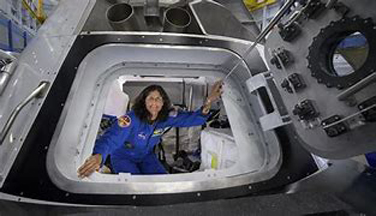WASHINGTON, D.C. (TIP): Veteran Indian American astronaut Sunita Williams is all set to go on her third mission to the international space station on May 6 on the first piloted flight of Boeing’s Starliner spacecraft. Williams and astronaut Barry “Butch” Wilmore, both former Navy test pilots, are set for the launch atop a United Launch Alliance Atlas 5 rocket at 10:34 pm EDT on Monday, May 6, according to a NASA statement.
If all goes well, Williams and Wilmore will dock at the space station on May 8 and return to Earth May 15 or shortly thereafter. If the mission goes well, NASA plans to begin operational Starliner crew rotation flights in 2025, alternating crew launches with SpaceX.
Williams and Wilmore, flew to the Kennedy Space Center Thursday afternoon to prepare for the first piloted launch of Starliner, a long-awaited flight running years behind schedule after two uncrewed test flights and extensive work to resolve a variety of technical problems.
Two of NASA’s most seasoned astronauts with four previous spaceflights, 11 spacewalks and 500 days in orbit between then, landed at the spaceport’s 3-mile-long runway in T-38 jet trainers after a flight from the Johnson Space Center in Houston.
“This is where the rubber meets the road, where we are going to leave this planet, and that is pretty darn cool!” Williams told reporters on the runway.
Completing the Starliner’s Crew Flight Test, or CFT, will “broaden (NASA’s) capability to and from the space station, and that’s vitally important,” said Wilmore. “We’re excited to be here.”
Williams’ space odyssey began with Expedition 14/15 from Dec 9, 2006, to June 22, 2007. She launched with the crew of STS-116 and served as Flight Engineer. She set a record for women with four spacewalks totaling 29 hours and 17 minutes. She returned to Earth with the STS-117 crew in June 2007.
Her second space mission, Expedition 32/33 was from July 14 to Nov 18, 2012. She launched from the Baikonur Cosmodrome in Kazakhstan, along with Russian Soyuz commander Yuri Melnichenko and Flight Engineer Akihiko Hoshide of the Japan Aerospace Exploration Agency, on July 14, 2012.
She spent four months conducting research and exploration aboard the orbiting laboratory. Williams once again held the record for total cumulative spacewalk time with a time of 50 hours and 40 minutes.
NASA awarded two Commercial Crew Program contracts in 2014, one to SpaceX valued at $2.6 billion and the other to Boeing for $4.2 billion, to spur the development of independent spacecraft capable of carrying astronauts to and from the International Space Station.
The goal was to end reliance on Russia’s Soyuz in the wake of the space shuttle’s retirement and to resume launching American astronauts from US soil aboard American rockets and spacecraft. SpaceX kicked off piloted flights in May 2020, successfully launching two NASA astronauts on a Crew Dragon test flight to the space station.
Since then, SpaceX has launched 50 astronauts, cosmonauts and civilians to orbit in eight operational flights to the lab complex, three commercial visits and one privately funded flight to low-Earth orbit.
Boeing launched its Starliner on an unpiloted test flight in December 2019, but the spacecraft experienced major software and communications problems that combined to derail an attempt to dock with the space station and almost led to the crew ship’s destruction.
A second unpiloted flight was ordered (and paid for by Boeing), but during an August 2021 launch window engineers discovered corroded valves in the spacecraft’s propulsion system. Fixing that problem delayed the second test flight to May 2022.
While the mission was successful, additional problems were discovered, including parachute issues and concern about possibly flammable protective tape wrapped around internal wiring. Correcting those problems and finding room for a visit in the space station’s complex flight schedule, eventually delayed the Crew Flight Test to May 6.
Indian American astronaut Sunita Williams set for first piloted launch of Boeing’s Starliner

Sunita Williams is all set to go on her third mission to the international space station on May 6 on the first piloted flight of Boeing’s Starliner spacecraft.